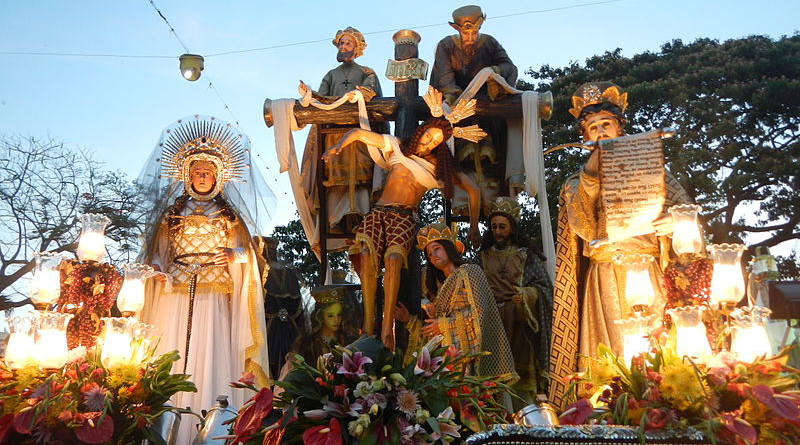The Resurrection Of Holy Week In The Philippines – OpEd
By UCA News
By Jose Mario Bautista Maximiano*
(UCA News) — The Easter Triduum, from Maundy Thursday to Black Saturday, is considered a statutory holiday in the Philippines, and local television and most radio stations usually go off the air. Trading and businesses are closed.
Work was only half-day for Holy Wednesday to allow all Filipino workers to observe the solemn days leading to Easter, the most important day in the Christian calendar, even more important than Christmas Day.
And the world witnesses the uniqueness of the Filipino observance of Holy Week.
During this time of year, much anticipated as one of the annual long weekends, the world will see crowded churches, processions and Visita Iglesia after these activities were temporarily prohibited in the past two years due to Covid-19.
“The activities of churches will resume and the public will be allowed to participate in these activities,” still wearing masks and observing physical distancing, Catholic Bishops’ Conference of the Philippines (CBCP) public affairs committee executive secretary Father Jerome Secillano recently announced.
For processions, the CBCP has recommended putting religious images in motorized vehicles instead of having people push caroza or andas (floats) on which images are placed. “And it was suggested that at least we shorten the routes of the processions,” Father Secillano said.
Visita Iglesia is the Catholic penitential tradition of visiting at least seven different churches during Holy Thursday and Good Friday.
For some, it is a chance to share the same experience Jesus had during the crucifixion, although there is a lingering belief in them that people who complete all stations will be rewarded. For others, they take this annual event as an opportunity for sightseeing.
True to Filipino ingenuity, there has been a Bisikleta Iglesia since 2012 where the pilgrimage has been made on bikes and motorbikes.
Suffice it to say that, in general, for many Christians, the essence of Lent, particularly the observance of Holy Week, rests on Easter. The essence of the penitence, fasting and prayers on Good Friday lies in the Resurrection of Jesus, for the cross and suffering of the Savior lies the hope of the New Life.
The most fundamental reason why they practice silence, fast, give alms to others, crowd churches to participate in liturgical events is this: Lenten sacrifice and death to oneself (mortification) lead them to the joy of Easter.
Hence, the most important of all processions for good Catholics is the Salubong, a unique tradition of the meeting of the images of the Risen Christ and Mary, usually held at dawn on Easter Sunday.
If truth be told, the Spanish-influenced Catholic rituals such as processions, Visita Iglesia, self-flagellation and other practices have been syncretized with elements of fanaticism and ritualism.
This is unmistakable in some practices that are not sanctioned by the official Church and in other superstitious beliefs associated with the Holy Week.
This is also evident in crowded places known as “sacred mountains.” One of them is Banahaw. With its mysterious caves and gigantic boulders, Banahaw has become a pilgrim’s home and a sacred site, believed by many to be a miraculous mountain.
For local residents, Mount Banahaw is a keeper of religious secrets and cults. Filipinos make the pilgrimage to Banahaw’s slopes to witness a miracle, fulfill a religious duty (panata) or restore their spiritual health.
Belief in its sacred and miraculous powers draws pilgrims from all over the country year-round, culminating in massive assemblies of devotees during Holy Week.
The mountain is popular not only with pilgrims but also among hikers and mountain climbers since it is the closest mountain over 6,600 feet from Manila. Hiking and mountain climbing are popular during Holy Week each year.
And the third most crowded places are the beaches. Hotels, resorts, staycation lodges and bars along these beaches made this announcement as early as March: “Holy Week 2022 — Great Places and Destinations for a Relaxing Long Weekend!”
Many residents depart Manila, leaving the city a ghost town on Good Friday. As a highly anticipated long weekend, Filipinos plan ahead to go on vacation, resulting in a peak season for most tourist destinations.
“Oppressed by lockdowns and isolation for two years, my family needs freedom, in a sense,” said Jake Marcelino of Pandacan, Manila. “We’ll go as far away as we can to get some fresh air.”
During this time of year, the world witnesses a sea of human beings at many beaches across the archipelago of 7,000 islands. Local and international tourist arrivals on Boracay island, although affected by Tropical Storm Megi in recent days, are increasing. Authorities on Boracay remind people, nonetheless, that wild parties on the island are not allowed — for now.
We recall that, during Holy Week, for many young Filipinos a trip to Boracay until 2019 meant a very long weekend of sin: drinking and dancing until the sun came up.
Things seem different this year. The restrictions to deal with the Covid-19 pandemic have mellowed the party island, which is now offering more wholesome fun for Holy Week — for now.
I am a senior citizen and in my youth, insofar as I remember, beaches were empty during the observance the holiest week of the year. Times have really changed.
* Jose Mario Bautista Maximiano is the author of ‘MDXXI: 500 YEARS ROMAN CATHOLIC’ (Claretian, 2020) and ’24 PLUS CONTEMPORARY PEOPLE: God Writing Straight with Twists and Turns’ (Claretian, 2019).

